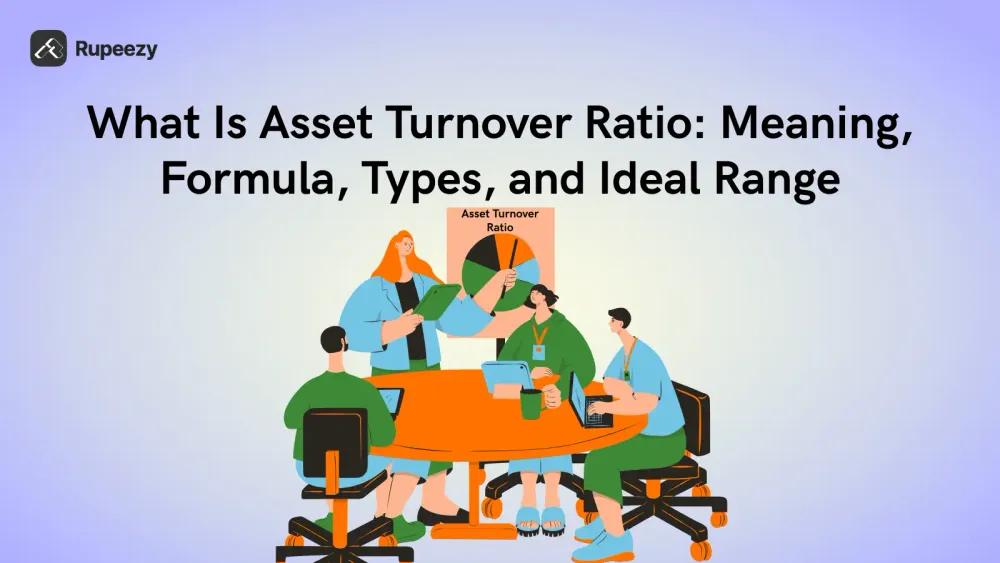What Is Asset Turnover Ratio: Meaning, Formula, Types, and Ideal Range


00:00 / 00:00
Investing in stocks and shares requires you to understand the market well. Starting from exploring the company to knowing how the industry works, you need to actually consider all the minute aspects to make the right call.
This is where you would analyse the trends, patterns, and news. Also, you would need to perform financial, ratio, and technical analysis. While there are many ratios that you can use, a few stand out. Like the current and quick ratio, which helps you to learn about liquidity. Likewise, there is the asset turnover ratio.
But the question is, what is the asset turnover ratio, and is there an ideal asset turnover ratio? Well, read this guide to know all the details you need to know.
What Is Asset Turnover Ratio
The asset turnover ratio shows how well a company uses its assets to generate revenue. It tells you how much sales a business earns for every rupee invested in its assets. So, when you interpret the asset turnover ratio, here is what it means:
A higher ratio means the company is using its resources well.
A lower ratio means the resources are not used properly.
The ideal asset turnover ratio is 1. This means that for every Rs. 1 invested in an asset, you are earning a revenue of Rs. 1 as well.
To ensure that you are interpreting the company performance correctly, you must use this ratio with say PB ratio, PE ratio, and others. This will help you understand the stability and growth with no waste of assets.
The general asset turnover ratio formula is:
ATR = Net Sales? /Average Total Assets
Where,
Net sales are total revenue from sales after removing taxes, discounts, and allowances.
Average total assets is the average of the asset value at the beginning and at the end of the period.
Types of Asset Turnover Ratio
The types of the asset turnover ratio are based on the nature of the assets used in the calculation. These are as follows:
1. Total Asset Turnover Ratio
This measures how much revenue a company generates from all its assets. It shows how well the assets are used by the company. This includes everything from machinery to inventory. Companies with steady sales and lean operations usually show a higher number.
2. Net Asset Turnover Ratio
This ratio looks at total assets after deducting liabilities. It shows how well a company uses its net assets to create revenue. It becomes useful when you want a more realistic efficiency picture, especially for businesses with high debt.
3. Fixed Asset Turnover Ratio
This focuses only on long-term assets like plants, equipment, and machinery. It helps you judge how productive these assets are. Industries that depend heavily on fixed assets often monitor this closely to see if their investments are paying off.
4. Working Capital Turnover Ratio
This checks how efficiently a company uses its working capital to generate sales. It becomes helpful for businesses that handle a lot of inventory or day-to-day operations. This is a must for businesses that need more cash flow.
The table below shares a quick highlight of the types.
Ratio Name | Formula | Ideal Ratio | Interpretation |
Total Asset Turnover Ratio | Revenue ÷ Total Assets | 1 to 2 for most industries | High means strong asset use. Low means weak utilisation. |
Net Asset Turnover Ratio | Revenue ÷ Net Total Assets | Above 1 | High shows efficient net asset use. Low shows poor efficiency. |
Fixed Asset Turnover Ratio | Revenue ÷ Fixed Assets | 2 or higher | High means productive machinery. Low means underused fixed assets. |
Revenue ÷ Working Capital | Varies by industry | High shows fast sales conversion. Low shows slow movement. |
Factors Affecting Asset Turnover Ratio
Several business elements can impact the asset turnover ratio. These include the following:
1. Sales Growth or Decline
If sales increase without adding many new assets, the ratio rises. When sales drop, the ratio falls even if assets stay the same.
2. Asset Expansion
Buying new machinery, vehicles, or property increases total assets. But if these assets fail to generate returns, your revenue drops.
3. Inventory Management
Slow-moving or excess inventory blocks capital and reduces sales efficiency. Fast-moving inventory increases the ratio.
4. Operational Efficiency
An increase in sales based on working better, a better process, or a reduced cost is good. This improves the ratio and performance.
5. Industry Nature
Some industries have lower ratios due to more fixed assets. While service-based industries usually have a high ratio.
6. Asset Age and Utilisation
Old or underused assets reduce productivity and pull the ratio down. Regular upgrades or better utilisation improve it.
Pros and Cons of Asset Turnover Ratio
The asset turnover ratio helps you assess how efficiently a company uses its assets. But there are some limitations as well that you must know.
Pros
Shows how effectively assets generate sales.
Helps compare efficiency within the same industry.
Useful to find assets that need improved usage.
Highlights strong operational performance and increasing sales.
Cons
Not suitable for cross-industry comparison.
Does not reflect profit margins.
Falls during expansion phases, even if investments are strategic.
Does not reveal asset condition or quality.
Conclusion
The asset turnover ratio helps you see how well a company turns its assets into revenue. It supports better stock research and helps you to find companies with a positive outlook. But using the asset turnover ratio alone is not enough. Hence, use others and look for the ideal asset turnover ratio. And if you are looking for tools and guidance, register on Rupeezy to start investing right.
FAQs
Why do investors use asset turnover ratio?
It helps check how well a company converts its assets into revenue.
Is a higher ratio always better?
Not in every case. It must fit the company’s industry and business model.
Which ratios work well with this one?
Profit margins, ROA, and debt ratios give a balanced view.
Can two companies have the same ratio yet differ?
Yes. Their asset mix, growth stage, and efficiency may vary.
What can change this ratio over time?
Shifts in sales, asset purchases, or operational changes can move the ratio.
The content on this blog is for educational purposes only and should not be considered investment advice. While we strive for accuracy, some information may contain errors or delays in updates.
Mentions of stocks or investment products are solely for informational purposes and do not constitute recommendations. Investors should conduct their own research before making any decisions.
Investing in financial markets are subject to market risks, and past performance does not guarantee future results. It is advisable to consult a qualified financial professional, review official documents, and verify information independently before making investment decisions.

All Category










